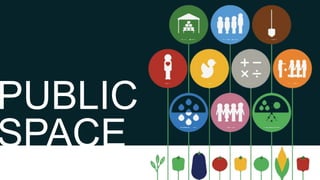Public Space
- 1. PUBLIC SPACE
- 2. ONE SPACE FOR ALL
- 3. âpublic space or a public place is a place where anyone has a right to come without being excluded because economic or social conditions (fees, paying an entrance, being poor, ...).âWebster's Online Dictionary
- 5. TOWN SQUARE
- 8. PATHWAY S
- 9. PARK S
- 10. SPACE SYMBOL
- 11. TAHRIR SQUARE
- 12. AGOR A
- 13. SLAB SQUARE
- 15. A SQUARE OR PLAZA IS BOTH AN AREA FRAMED BY BUILDINGS AND AN AREA DESIGNED TO EXHIBIT ITS BUILDINGS TO THE GREATEST ADVANTAGE.
- 18. Squares in Bath
- 20. Function Form
- 28. FOCUS ON
- 29. When you focus on SPACE you do everything differently
- 30. PLASPAC E
- 31. WHAT MAKES A GREAT PLACE?
- 32. PUBLI C +SOCIABILITY ACCESS & LINKAGES COMFORT & IMAGE Intangible s Measurement s Welcoming Cooperative Neighborly Fun Active Vital Special Real Connected Walkable Convenient Accessible Safe Charm Clean Attractive Historic USES & ACTIVITIES
- 33. Itâs hard for people to realize that place is more important than design. âFred Kent
- 34. THE POWER OF TEN âĶâĶâĶâĶâĶ.?
- 36. âThe way to get started is to quit talking and begin doingâ -Walt Disney
Editor's Notes
- #5: The types of space needed in a city are: thesetting for a civic building;
- #6: the principal meetingplaces; places for great ceremonial occasions;
- #7: spacesfor entertainment around buildings such as theatres,cinemas, restaurants and cafes;
- #8: spaces for shopping,shopping street, arcades and markets;
- #9: spaces aroundwhich offices are grouped; spaces of a semi-publicnature around which residential accommodation isarranged; and, finally, the spaces associated withurban traffic junctions.
- #11: The single most important function of an elementin the city is the symbolic meaning attached to it.All great civic art is in tune with the profounddepths of our emotions. The great plaza, like thegreat building, is linked with the world of fantasy,the context of feeling
- #13: Since ancient times, a city square â be it agora, town hall square or market square â hasbeen a public space: A centre of public, political and social life in European towns, a place ofsociability where citizens could gather, for discussions, for spending their leisure time
- #14: To some extent this still occurs in some European cities; even a city such as Nottingham hasits centre, Market Square, or âSlab Squareâ as it is affectionately known by locals. It is still the hubof social life and place of great and diverse activities.
- #17: Great civic compositions such as St Markâs Square, Venice
- #18: St Peterâs Square, Rome
- #19: and the group of squares in Bath by John Wood and his son are unique in the relationship between space, the surrounding buildings and the dome of the sky;
- #20: they demand an emotional and cerebral response and, as such, compare with any other art form.
- #21: There are two main methods of categorizing squares â by function and by form.
- #22: There are numerous examples of recent plaza design where one or other of these two equally important criteria of excellence have been neglected. The empty windswept place surrounded by under-utilized buildings is all too common in the modern city, while its opposite or counterpart, the busy traffic island or faceless car park around which are scattered collections of non-related buildings, is also endemic in the urban scene.
- #23: For Sitte, the most important is not the architectural shape or form of each building, but the inherent creative quality of urban space, the whole as much more than the sum of its parts.Â
- #24: Sitte takes up this point in a number of places in his treatise â. . . that in the Middle Ages and the Renaissance there still existed a vital and functional use of the town square for community life and also,
- #25: in connection with this, a rapport between square and surrounding public buildings. . .
- #26: In short, we miss activity exactly where in Antiquity it was most animated, that is, around the great public buildings
- #27: Piazza S. Maria NovellaStanding at any point inthe Piazza S. Maria Novella, Florence, it is impossibleat first glance to tell that this is a five-sidedspace. To all intents and purposes it is a regularsquare
- #31: WHAT MAKES A SPACE A PLACE?
- #33: distance
- #36: distance




































